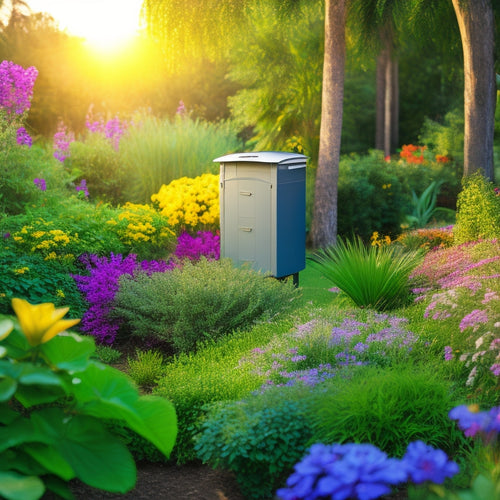
Recycle Greywater: Boost Your Organic Garden's Efficiency
Share
By recycling greywater, you can greatly reduce your potable water usage for irrigation, making your organic garden more efficient and eco-friendly. Greywater, which comes from sources like showers, sinks, and washing machines, can be treated and reused to water plants, reducing wastewater and conserving potable water. With the right system design, treatment options, and irrigation methods, you can create a thriving garden while minimizing environmental impact. By investigating the world of greywater recycling, you'll uncover how to optimize your garden's efficiency and make a positive difference for the planet - and there's more to examine on this path to sustainable gardening.
Key Takeaways
- Recycling greywater reduces exposure to chemicals and contaminants from traditional water sources, promoting environmental health and soil quality.
- Greywater sources include laundry discharge, shower runoff, sink wastewater, and kitchen drainage, which can be treated and reused for irrigation and toilet flushing.
- Effective greywater treatment options include filtration techniques, aerobic treatment units, bioreactors, and DIY solutions like mulch basins or greywater ponds.
- Choosing the right greywater system involves considering design options, renewable energy solutions, and irrigation methods like drip irrigation and soaker hoses.
- Proper installation, maintenance, and water storage solutions are crucial to ensure a leak-free, efficient, and eco-friendly greywater recycling system.
Benefits of Greywater Recycling
Sustainability shines a spotlight on greywater recycling, revealing a wealth of benefits for organic gardeners.
You'll enjoy significant health benefits from using greywater, as it reduces your exposure to chemicals and contaminants found in traditional water sources.
By adopting renewable energy sources, such as high-efficiency solar panels, you can further reduce your carbon footprint and create a more eco-friendly garden.
Greywater recycling also has a positive environmental impact, as it decreases the amount of wastewater entering waterways and conserves potable water.
You'll appreciate the cost savings too, as you'll use less potable water for irrigation.
By incorporating greywater into your gardening techniques, you'll enhance your soil, promoting healthy plant growth.
As you adopt sustainability practices, you'll experience the rewards of a thriving, eco-friendly garden.
Understanding Greywater Sources
As you investigate the world of greywater recycling, it's essential to identify the sources of greywater in your home. You'll find greywater in various areas, and understanding these sources is key to maximizing recycling benefits.
| Greywater Source | Description | Potential Uses |
|---|---|---|
| Laundry Discharge | Water from washing machines | Outdoor irrigation, flushing toilets |
| Shower Runoff | Water from showering | Watering plants, outdoor irrigation |
| Sink Wastewater | Water from kitchen and bathroom sinks | Watering plants, flushing toilets |
| Kitchen Drainage | Water from kitchen appliances | Outdoor irrigation, flushing toilets |
| Other Sources | Dishwasher, bath, and floor drain water | Various uses, depending on the system |
Choosing the Right System
You're now ready to choose a greywater system that suits your organic garden's needs.
You'll need to take into account two main factors: system design options and the types of grey water sources you'll be using.
As you evaluate these factors, keep in mind the importance of renewable energy solutions in reducing your carbon footprint.
By incorporating sustainable energy sources, such as solar panels or biodiesel fuel systems, you can further enhance your garden's efficiency.
System Design Options
Your greywater recycling system's design determines its effectiveness in irrigating your organic garden. A well-designed system guarantees efficient water distribution, minimizes maintenance, and promotes healthy plant growth. You have three main system types to choose from:
| System Type | Description | Design Considerations |
|---|---|---|
| Branched Drain | Greywater flows through a network of pipes to multiple irrigation points | Requires careful pipe sizing and layout planning |
| Sequential | Greywater is distributed to irrigation points in a set sequence | Suitable for gardens with varying water demands |
| Irrigation Controller | Greywater is distributed based on soil moisture levels and plant water requirements | Requires sensors and automation equipment |
When designing your system, consider factors such as water flow rates, pipe material selection, and potential clogging points. By selecting the right system type and design considerations, you'll create an efficient and effective greywater recycling system for your organic garden.
Grey Water Sources
Three primary sources of greywater in your home can be employed to irrigate your organic garden: sinks, showers, and washing machines. These sources offer a substantial amount of water for outdoor usage, reducing your environmental impact.
Sinks, particularly the kitchen sink and bathroom basin, generate greywater rich in nutrient content, ideal for fertilizing your plants. Showers produce a significant amount of shower runoff, while washing machines generate laundry waste that can be recycled.
By integrating renewable energy sources into your greywater system, you can further minimize your carbon footprint. Additionally, considering sustainable charging solutions for electric vehicles can complement your eco-friendly gardening practices.
When choosing a collection system, consider filtration methods and regulatory compliance to ascertain efficient and safe greywater reuse. By utilizing these sources, you'll reduce your water consumption and create a more sustainable organic garden.
Greywater Treatment Options
Frequently, homeowners and gardeners opting for a more sustainable approach to gardening are faced with the challenge of treating greywater effectively.
You'll need to choose a treatment method that suits your system's efficiency and your budget. Implementing renewable energy sources, such as solar energy reduction, can also enhance the overall eco-friendliness of your gardening routine.
Filtration techniques, such as aerobic treatment units or bioreactors, can be effective, but may require significant cost considerations. DIY solutions, like mulch basins or greywater ponds, can be more affordable and environmentally friendly.
However, it's crucial to research local legal regulations and verify your treatment method meets the standards.
Don't fall for greywater myths - with proper treatment, you can recover beneficial nutrients for your garden while minimizing environmental impact.
Irrigation Methods for Gardens
Most homes generate a substantial amount of greywater daily, which can be a significant resource for irrigation. When it comes to irrigation methods, you have several options to choose from, each with its own benefits and drawbacks.
| Irrigation Method | Water Efficiency | Soil Erosion Risk |
|---|---|---|
| Drip Irrigation | High | Low |
| Soaker Hoses | Medium | Medium |
| Sprinkler Systems | Low | High |
Drip irrigation and soaker hoses are great options for greywater irrigation, as they reduce evaporation and runoff. These methods also promote healthy plant growth by supplying water directly to the roots. By choosing the right irrigation method for your garden, you can maximize the benefits of greywater recycling and create a more sustainable and efficient garden.
Designing an Efficient System
You'll want to map out grey water flow paths to guarantee efficient distribution throughout your garden.
When selecting system components, consider factors like water pressure, flow rate, and pipe material to guarantee a leak-free setup.
To minimize energy waste, it's crucial to optimize your solar panel array and select energy-efficient equipment for your irrigation system.
Grey Water Flow Paths
Through careful planning, you can design a grey water flow path that efficiently distributes treated wastewater to your organic garden, minimizing waste and maximizing its potential benefits.
Consider your garden's layout, soil type, and plant water requirements to determine the ideal flow rate for your system. You'll need to decide on distribution methods, such as gravity-fed or pumped systems, to get the grey water to where it's needed most.
A well-designed flow path guarantees that water is delivered consistently and efficiently, reducing the risk of overwatering or underwatering. By balancing flow rate and distribution, you can create a thriving ecosystem that benefits from this precious resource.
System Component Selection
As you initiate designing an efficient grey water system, selecting the right components is essential to guarantee a seamless and effective distribution of treated wastewater to your organic garden.
You'll need to choose system components that can handle the volume and flow rate of your grey water. Material selection is significant, as it affects the system's durability and resistance to corrosion.
Opt for non-toxic, UV-resistant materials like PVC, ABS, or HDPE for pipes and fittings. Confirm that your pumps, valves, and filters are designed for grey water use and can withstand the water's unique characteristics.
Water Storage Options
In designing an efficient grey water system, one crucial aspect to take into account is where to store the treated wastewater before it reaches your organic garden.
You'll want to choose a storage option that's both practical and eco-friendly. Underground storage tanks are a great option, as they can be installed beneath your garden, reducing visual impact and keeping the water cool.
Additionally, consider combining grey water storage with rainwater harvesting to maximize water collection. This won't only reduce your water bill but also decrease your reliance on municipal water supplies.
Installation and Maintenance Tips
Your greywater system is up and running, and now it's time to verify it continues to function efficiently and effectively.
During installation, ascertain your system is sloped correctly to prevent waterlogging and bad odors. Implement proper drainage solutions, such as a French drain or a mulch basin, to direct greywater into your soil.
Regularly inspect your system for signs of clogging or damage, and perform routine maintenance tasks like cleaning filters and checking valve operations.
Consider health considerations by using gloves and protective gear when handling greywater, and avoid ingesting or inhaling greywater mist.
Common Challenges and Solutions
Occasionally, greywater system users encounter challenges that can hinder the efficiency of their setup. You might face issues with water quality, which can affect your plants' health. For instance, high levels of contaminants or bacteria can be detrimental to your garden.
To tackle this, regularly inspect your system, and perform routine maintenance tasks like cleaning filters and checking for clogs. Additionally, verify you're following local plumbing regulations to avoid any legal hassles.
Another common issue is incorrect system design or installation, leading to poor water distribution. To overcome this, consult with a professional or take online courses to learn more about greywater system design and installation best practices.
Maximizing Water Savings
By utilizing greywater, you're already taking a substantial step towards water conservation.
Now, let's examine ways to maximize your water savings. Implementing water conservation strategies into your sustainable gardening practices can considerably reduce your water footprint. Start by identifying areas where you can optimize your greywater system's efficiency. Check for leaks, verify proper drainage, and adjust your irrigation schedule according to weather conditions.
Additionally, consider implementing drought-tolerant plants and mulching to reduce evapotranspiration. By adopting these practices, you'll not only conserve water but also reduce your energy consumption and lower your water bills.
Frequently Asked Questions
Can I Use Greywater for My Indoor Plants and Flowers?
You can definitely use greywater for your indoor plants and flowers, reaping greywater benefits like reduced water bills and healthier plants; just be sure to use it correctly for ideal indoor plant care and a thriving, eco-friendly space.
How Often Should I Inspect My Greywater System for Clogs?
You're worried you'll forget to check your greywater system, but don't worry, it's easier than you think! You'll want to inspect your system every 1-3 months to prevent clogs, sticking to a maintenance schedule to keep your eco-friendly setup flowing freely.
Are There Any Specific Greywater Regulations in My State?
You'll want to check with your state's environmental agency to see if they have specific regulations on greywater treatments and conservation practices, as these can vary, but it's crucial to guarantee you're doing your part for the planet's freedom.
Can I Connect Multiple Sources to a Single Greywater System?
You can connect multiple greywater sources, like sinks and showers, to a single system, increasing water efficiency and reducing waste, as long as you guarantee proper system connections and maintenance to avoid clogs and contamination.
Will Greywater Affect the Ph Balance of My Soil?
You're right to wonder if greywater will disrupt your soil's pH balance, but the good news is that it can actually improve soil health by introducing beneficial microbes, which can help stabilize the pH and release greywater benefits.
Related Posts
-

7 Best Cool Roof Rebates for Energy-Savvy Homeowners
You're an energy-savvy homeowner looking to install a cool roof, and you're wondering which rebates can help you save...
-

Why Choose Solar Composting Toilets for Your Home?
By choosing a solar composting toilet for your home, you'll greatly reduce your environmental impact, slashing your w...
-

Why Grow Up? Vertical Gardens Transform Urban Living
As you change your urban living space, you're not just growing up - you're bringing nature back into the heart of the...


